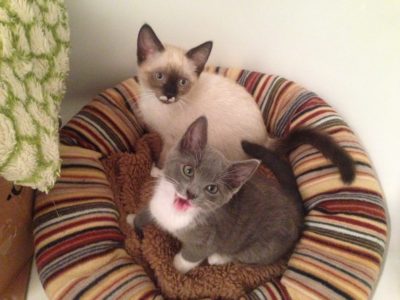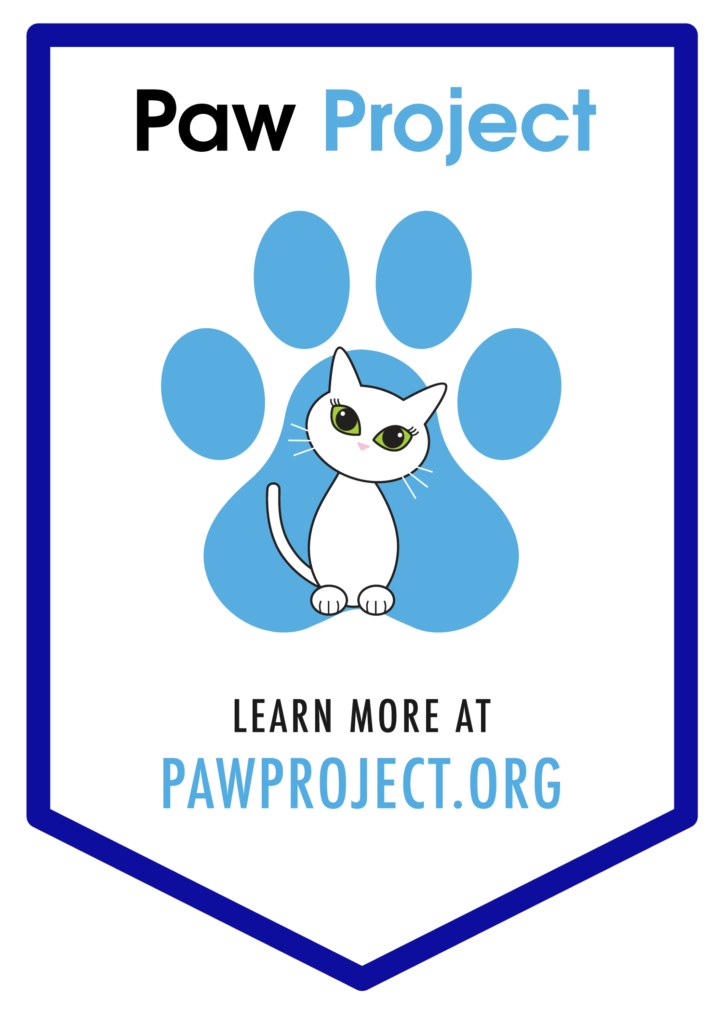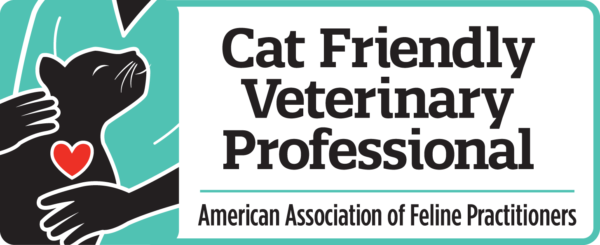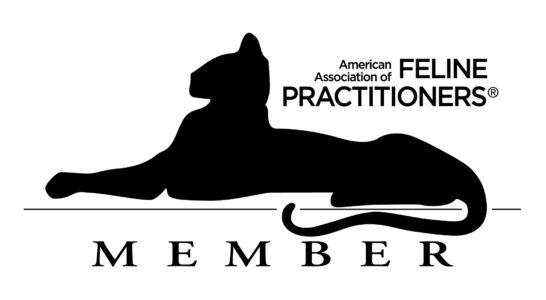- Canned food is an excellent way to encourage water consumption, because it is high in water content and most cats love the taste. It can be warmed up in the microwave to enhance its smell. We recommend feeding canned food one to three times a day in addition to freely fed dry food. You can also add water to the canned food.
- If your cat prefers to drink from a tap, make sure she can always get to the tap-don’t lock her out of the bathroom if that is where she likes to drink. If your schedule permits, turn the tap on for your cat as often as possible throughout the day. Do not allow your cat (or dog) to drink from the toilet-chemical residue can be toxic! Water fountains can be purchased for cats that like fresh flowing water. E-Z faucet is a motion activated device that will turn the tap on for your cat when you are not home!
- Provide fresh water every day. Cats are very sensitive to the temperature and taste of water.
- Make sure the water bowl is filled to the brim at all times. Cats have very sensitive whiskers and do not like putting their face into a bowl; a wider bowl may be necessary.
- Some cats do not like the taste of tap water. You might wish to try:
- Refrigerating the tap water to improve its taste
- Filtered water (Brita or Pur home filters are widely available)
- Distilled water
- Bottled water
- Some cats will drink more water if a drop or two of tuna or chicken juice is added. If you try this, always make sure a separate bowl of fresh water is available. You can try adding clam juice too.
- Some cats enjoy ice cubes made from flavored broth. You can make a broth by simmering 6 oz of tuna or salmon mixed with 2 cups of water for 10 minutes. Strain the mixture through cheesecloth and pour into ice cube trays.
- Keep the food and water bowls away from litter box areas.
- Clean the water bowl daily. Cats have a keen sense of smell and are easily turned off by odors on the edge of the bowl. Stainless steel or glass dishes are easier to keep clean and odor free vs. plastic dishes. Some cats seem to prefer a clear shallow glass bowl from which to drink. Ideally food and water bowls should be separate. In nature they are not lucky enough to kill their prey near a puddle. Studies have shown that cats drinks more if bowls are separated by at least 2 feet.
- If your cat tends to tip the water bowl over, weigh down the bowl by placing a large stone that has been thoroughly washed into it, or try a commercially available weighted or tip-free bowl.
Hand Out
Medicating Tips
Pill Pockets:
Pill Pockets are a soft chew with a hollow center with room for a pill inside. We recommend giving them to your cat as a treat first, get your cat hooked, then spike one with the pill. They are available in chicken or salmon flavor. Pill Pockets also make great treats for healthy cats knowing they will likely need a pill at some point in the future.
Flavor Doh:
Flavor Doh is a tub of flavored moldable dough-similar to Pill Pockets-but you use only what you need to cover the pill or capsule completely. This option allows you to hide larger pills or capsules. It is available in chicken or fish flavor.
Baby Food:
Cats love single ingredient human baby food! Try crushing the tablet and mixing into a teaspoon of baby food. Make sure that there are no other ingredients such as onion powder as they can be harmful to your cat. We recommend Gerber 2nd stage Chicken and Gravy, Turkey and Gravy or Beef and Gravy.
Tuna Water:
Tuna meat is not good for your cat, but the water that is poured off the can is a great medicating tool. Simply crush the tablet and mix into the tuna water. You can also mix liquid medication into tuna water to ease administration.
Canned Cat Food:
Many medications can be disguised in your cat’s favorite canned food, or you may choose to use a canned food that is different from what they get each day so that it is special and they only get a small amount at meds time.
Kitty Burrito:
If your cat tries to push your hand away with her paw, try wrapping her in a kitty burrito. Place your cat in the center of a towel and wrap one side at a time over her, leaving only her head sticking out. Make sure it is not too tight around the neck, but tight enough so she can’t get her paws out. Ask us for a demonstration, or view this technique online at the website listed at the end of this handout.
Pill Gun:
A pill gun is a plastic rod with a little rubber cup on the end that holds the pill until the plunger is pressed. It is helpful to use a pill gun if your cat tends to clench their jaw or bite when being pilled. The pill gun can be used either with the scruffing technique or the check bone technique as shown at the website listed at the end of this handout.
Be prepared:
Try keeping medications and supplies in an area where you already spend time with your cat. Keeping things at home as routine as possible will make it easy for you and less stressful for your cat. This will also often times prevent your cat from “catching on” and hiding from you at meds time.
Ask For Options:
If you are having trouble medicating your cat, don’t give up. Ask if there are other options available. Some tablets are available in a liquid form and there are compounding pharmacies that may be able to offer you flavored chewable treats or, in rare instances, a transdermal gel that is simply rubbed on the skin. If you’re struggling to administer necessary medications, our staff offers “pilling” lessons and there may be a pet sitter in your area that can come by and help.
Oral Syringe Parfait:
- Using a 6ml and a 3ml oral medicating syringe and some soft canned food, preferably Science Diet a/d or baby food, draw up 3mls of food in the 3ml syringe.
- Completely pull out the plunger of the 6ml syringe.
- Place the full 3ml syringe down inside the 6ml and express the food, withdrawing the 3ml syringe as you go. This creates a foundation of food at the tip of the 6ml syringe.
- Place any liquid or crushed medication inside the 6ml syringe.
- Place 2mls of food on top of the medication using the 3ml syringe. You are now done with the 3ml syringe.
- Your syringe should now be layered food/medication/food.
- Place the 6ml plunger back into the barrel of the 6ml syringe. A little food-about 1/2ml-will push out of the tip of the 6ml syringe, which is the purpose for putting such a large amount of food in first.
- Now you are ready to give this mixture to your cat. If your cat does not like it as a treat, simply syringe into their mouth using the technique described in the video link below.
Remember to be calm when trying to medicate your cat. If you are stressed or your kitty is upset, take a break and try again later. Make sure to keep a supply of oral syringes, Science Diet a/d, Pill Pockets and even a pill gun on hand so that you have options. Lastly, remember to always reward your cat after administering any type of medication or treatment. You can reward with treats, play time or affection and doing so will make your cat associate the meds time with something positive.
Visit www.FundamentallyFeline.com and click on How-To videos for more medicating help and tips.
Two Are Better Than One!
- By having two or more cats you are able to enjoy the true social nature of cats as a species. They naturally live in small groups called colonies. Cats are solitary hunters, but not a solitary species.
- Cats that have a playmate tend to be more socially well adjusted. They also tend to have less behavior problems related to social skills such as: predatory aggression (biting of hands and other appendages), scratching, hissing, hiding and overall shyness.
- Only cats are typically poorly socialized and much more aggressive to most anyone in their life. We commonly refer to these cats as having “only child syndrome” or “Tarzan”; they do not know what to do with another cat when faced with it years later.
- Cats need mental stimulation throughout the day, just like humans. Studies have shown that animals that live alone have smaller brains than their streetwise counterparts.
- In Switzerland, an anti-cruelty law was passed that requires people that are adopting or buying a dog or cat to acquire two since it is the nature of the animal to have company of its own kind.
- Cats that have a playmate to keep them active will have less of a tendency to be overweight and suffer related health issues.
- Destructive behaviors due to boredom and attention seeking are less common when they have a buddy. This means less scratching on furniture, getting into cabinets, chewing on wires, etc.
- When you travel or are gone at work all day they will have each other for company. Cats take comfort in simply the presence of another feline, they do not have to sleep together and groom each other to enjoy knowing one another are there.
- It is more common for people to return an adopted cat due to behavior problems when only one was adopted versus two.
- Your cat will likely remain more youthful and playful well into their senior years with the benefit of a companion.
- The workload to care for two cats versus one is virtually the same. The benefit of not having to be the sole provider of entertainment also makes two even easier than one!
- You do not need to have more space to have a second cat.
- Because………Two is better than one! For the humans, for the cats and for the pet overpopulation crisis!

This is Willow and Soren as babies. It is always best to adopt two kittens together.
Healthier, Safer, More Responsible: Indoor Only Cats
Indoor only cats live longer, healthier lives and have less risk of disease, injury or getting lost or stolen. Should you decide to give your cat supervised access to the outdoors, we recommend using a leash and harness or outdoor enclosure and making sure your cat has proper identification in the form of a microchip and a collar and tag. All cats, especially those with access to the outdoors should also be on heartworm and flea prevention. The following is a list of risks facing free roaming cats and the families that love them.
Free roaming cats are often targets of human cruelty. Cats may be shot, stabbed, set on fire or captured and used as bait to train fighting dogs. Some cats are stolen for research and sold to laboratories.
Free roaming cats may be prone to being “rescued” by a Good Samaritan who may take your cat in as one of their own or take your cat to a local shelter, veterinary hospital or animal control agency.
Cats get hit by cars, and that kills cats every day.
When people attempt to avoid hitting cats while driving they may be injured or killed. Your free roaming cat can cause a person to die.
Allowing your cat to roam freely decreases the human animal bond. Why is it acceptable to let your cat outside to wander the neighborhood when you would not let your dog out for 12 hours to roam unsupervised?
Free roaming cats are susceptible to fighting with other free roaming animals resulting in transmission of diseases, abscess wounds, scratched eyes or internal injuries causing increased cost of medical care. Diseases they may encounter include rabies, cytauxzoonosis, feline leukemia and FIV. No vaccine is 100% effective.
Free roaming cats are vulnerable to attacks from predators including coyotes, foxes, birds of prey and, unfortunately, free roaming dogs.
Free roaming cats may have medical emergencies that are not seen by their owners, such as seizures, strokes or worse. Sometimes the cats recover and return home, but the family never knows what happened. You cannot seek treatment for a medical issue of which you are not aware.
Free roaming cats may encounter many toxic dangers including antifreeze, pesticides, rodenticides, fertilizers, traps or toxic plants.
Free roaming cats are more likely to contract debilitating parasites such as worms, ticks, mites and fleas. Zoonotic diseases (transmissible from animals to humans) such as roundworms and rabies may be spread by outdoor cats.
Poop and pee are important to see! What is or is not in your cats litterbox are important indicators of the health of your cat. For example, too much or too little urine can be indicative of an important and possibly life threatening medical issue.
In cold climates, cats may crawl under car hoods to warm up. When the ignition turns, the cats are mangled. Additionally, they may seek refuge in crawl spaces, sheds and garages where they may be easily locked in, without food or water, for extended periods of time.
Free roaming cats may not find their way back home, especially senior cats.
Allowing your cat to roam freely is not good for the environment. They do in fact kill songbirds, small mammals and other wildlife.
Allowing your cats to be unsupervised outside may cause your neighbors to think of you as disrespectful. Free roaming cats cause behavior problems for neighbors' indoor only cats; roaming cats may eliminate on someone else's property, often in gardens. They may also relieve themselves on or scratch the hoods of cars.
Indoor only cats live an average of three times longer than outdoor cats.
What is the upside of being encouraged to roam the neighborhood? Life is more interesting outdoors, but far more dangerous too. Nothing listed above is opinion - it is all fact. We know these are real threats to cats allowed to wander outside. We just don't know exactly how often they occur. We know most of these things can't happen to indoor cats. Please reference our Environmental Enrichment handout for ideas on keeping your cat active, stimulated and happy within the safety of your home.






